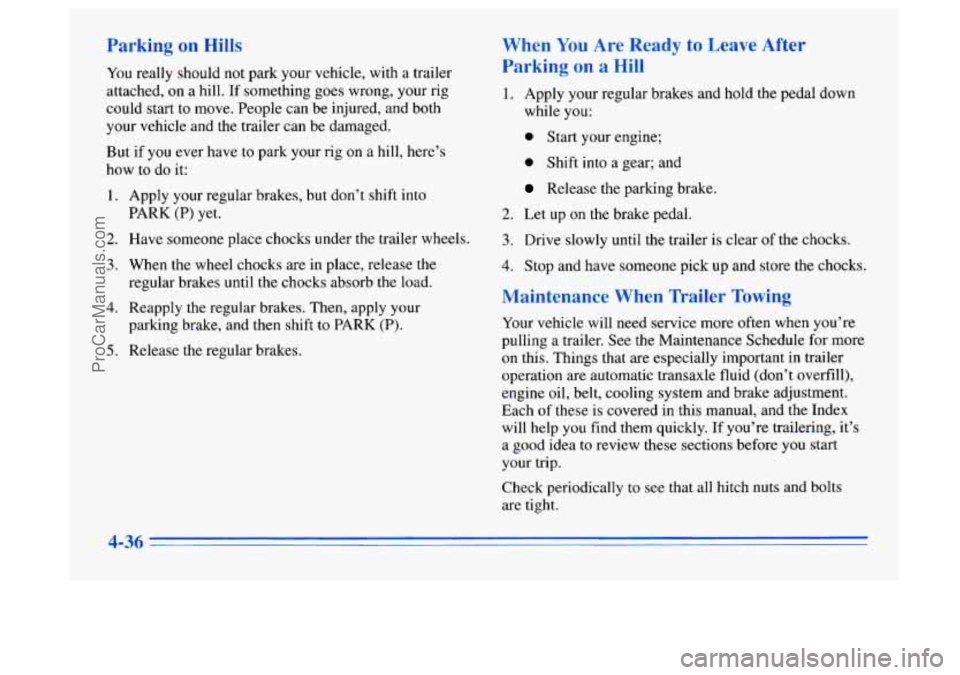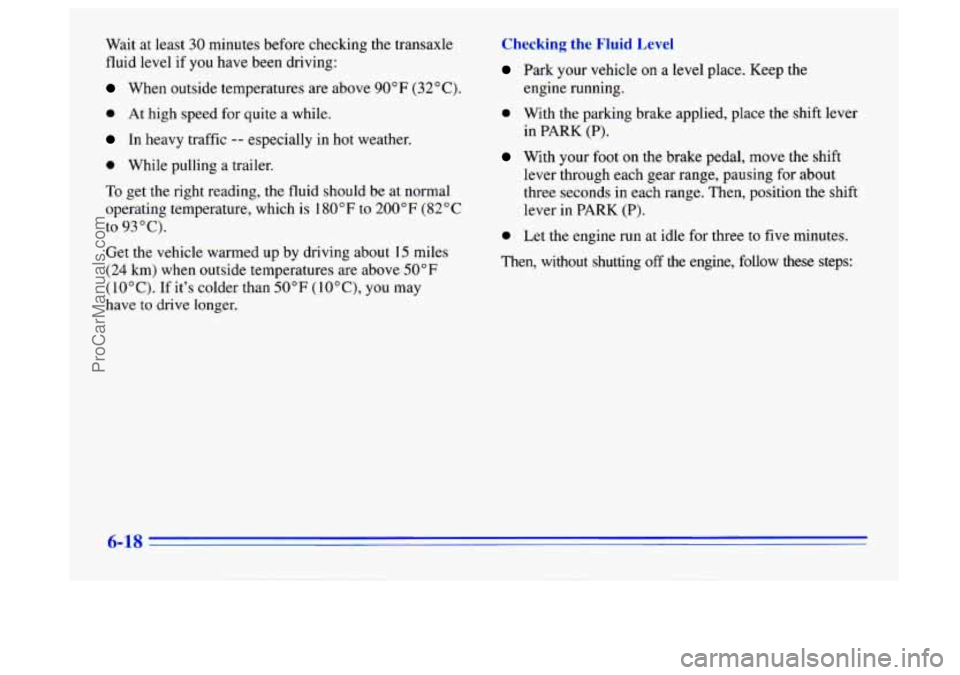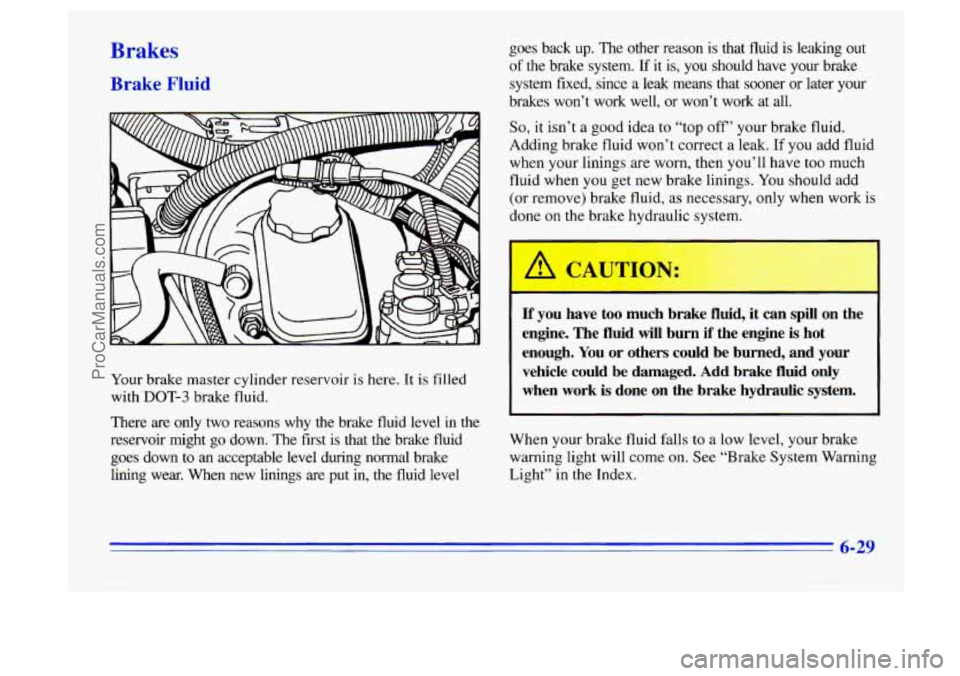Page 88 of 340
The rear window
washedwiper switch is at
the center of the instrument
panel. Press the top
of the
switch labeled
WASH and
the rear wiper will run at a
constant speed.
Press the switch further and hold
to spray washer fluid
while
the wiper continues to run. The wiper will
continue to run until you press the
OFF switch.
The rear window washer fluid reservoir is the same
reservoir as the windshield washer reservoir.
Cruise Control (Option)
With cruise control,
you can maintain
a
speed of about 25 mph
(40 km/h) or more
without keeping
your
foot on the accelerator.
This can really help on
long trips. Cruise
control does not work
at speeds below about
25 mph (40 km/h).
When you apply your brakes, the cruise control
shuts
off.
2-30
ProCarManuals.com
Page 153 of 340

If you drive regularly in steep country, or if you’re
planning
to visit there, here are some tips that can make
your trips safer and more enjoyable.
0 Keep your vehicle in good shape. Check all fluid
levels and also the brakes, tires, cooling system
and transaxle. These parts can work hard on
mountain roads.
Know how to go down hills. The most important
thing to know is this:
let your engine do some of the
slowing down. Shift to a lower gear when you go
down a steep or long hill.
If you don’t shift down, your brakes could get
so hot that they wouldn’t work well. You would
then have poor braking or even none going
down
a hill. You could crash. Shift down to let
your engine assist your brakes on
a steep
downhill slope.
A CAUTION:
Coasting downhill in NEUTRAL (N) or with the
ignition
off is dangerous. Your brakes will have to
do all the work
of slowing down. They could get so
hot that they wouldn’t work well. You would then
have poor braking or even none going down
a hill.
You could crash. Always have your engine running
and your vehicle in gear when you
go downhill.
I
Know how to go uphill. You may want to shift down
to a lower gear.
The lower gears help cool your engine
and transaxle, and you can climb the hill better.
Stay in your own lane when driving on two-lane
roads
in hills or mountains. Don’t swing wide or cut
across
the center of the road. Drive at speeds that let
you stay in your own lane.
As you go over the top of a hill, be alert. There could be
something
in your lane, like a stalled car or an accident.
You may see highway signs on mountains that warn
of special problems. Examples are long grades,
passing or no-passing zones,
a falling rocks area
or winding roads. Be alert to these and take
appropriate action.
4-23
ProCarManuals.com
Page 166 of 340

Parking on Hills
You really should not parK your vehicle, with a trailer
attached,
on a hill. If something goes wrong, your rig
could start to move. People can be injured, and both
your vehicle and the trailer can be damaged.
But if
you ever have to park your rig on a hill, here’s
how to do it:
1. Apply your regular brakes, but don’t shift into
2. Have someone place chocks under the trailer wheels.
PARK
(P) yet.
3. When the wheel
chocks are in place, release the
regular brakes until the chocks absorb the load.
4. Reapply the regular brakes. Then, apply your
parking brake, and then shift
to PARK (P).
5. Release the regular brakes.
When You Are Ready to Leave After
Parking on
a Hill
1. Apply your regular brakes and hold the pedal down
while
you:
m Start your engine;
0 Shift into a gear; and
Release the parking brake.
2. Let up on the brake pedal.
3. Drive slowly until the trailer is clear of the chocks.
4. Stop and have someone pick up and store the chocks.
Maintenance When Trailer Towing
Your vehicle will need service more often when you’re
pulling a trailer. See the Maintenance Schedule for more
on this. Things that are especially important in trailer
operation are automatic transaxle fluid (don’t overfill),
engine oil, belt, cooling system and brake adjustment.
Each of these is covered in this manual, and the Index
will help
you find them quickly. If you’re trailering, it’s
a good idea to review these sections before you start
your trip.
Check periodically to see that all hitch nuts and bolts
are tight.
4-
ProCarManuals.com
Page 214 of 340
When you open the hood of your 2.2L engine you’ll see:
D. Engine Oil Cap and Dipstick G. Engine Fan
E. Automatic Transaxle Dipstick H. Air Cleaner
F. Brake Fluid Reservoir 1. Battery
A. Windshield Washer Reservoir
B. Engine Coolant Reservoir
C. Power Steering Reservoir
6-8
ProCarManuals.com
Page 215 of 340
When you open the hood of your 3.1 L engine you’ll see:
A
A. Windshield Washer Reservoir
B. Engine Coolant Reservoir
C. Power Steering Reservoir
D. Automatic Transaxle Dipstick
E. Oil Fill Cap
E Engine Oil Dipstick
G. Brake Fluid Reservoir
H. Engine Fan
I. Air Cleaner
J. Battery
6-9
ProCarManuals.com
Page 216 of 340

Things that burn can get on hot engine parts and
start a fire. These include liquids like gasoline,
oil, coolant, brake fluid, windshield washer and
other fluids, and plastic or rubber. You or others
could be burned. Be careful not
to drop or spill
Underhood Lamp
Your underhood lamp is designed to come on whenever
you raise the hood.
Engine Oil
It's a good idea to check your engine oil every time you
get fuel. In order
to get an accurate reading, the oil must
be warm and the vehicle must be on level ground.
things that will burn onto a hot engine. Turn off the engine and give the oil a few minutes to
drain back into the oil pan. If you don't, the oil dipstick
Before closing the hood, be sure all the filler caps
are on properly.
Then lift the hood
to relieve pressure on the hood prop.
Remove the hood prop from the slot in the hood and
return the prop
to its retainer. Then just let the hood
down and close
it firmly. might
not show the actual level.
Checking Engine Oil
Pull out the dipstick and clean it with a paper towel or
cloth, then push it back in all the way. Remove it again,
keeping the tip down, and check the level.
6-10
ProCarManuals.com
Page 224 of 340

Wait at least 30 minutes before checking the transaxle
fluid level if
you have been driving:
When outside temperatures are above 90 OF (32 O C).
0 At high speed for quite a while.
In heavy traffic -- especially in hot weather.
0 While pulling a trailer.
To get the right reading, the fluid should be at normal
operating temperature, which is
180°F to 200°F (82°C
Get the vehicle warmed up by driving about
15 miles
(24 km) when outside temperatures are above 50°F
(10°C). If it's colder than 50°F (lO"C), you may
have
to drive longer.
to 93°C).
Checking the Fluid Level
Park your vehicle on a level place. Keep the
engine running.
0 With the parking brake applied, place the shift lever
in PARK
(P).
With your foot on the brake pedal, move the shift
lever through each gear range, pausing for about
three seconds
in each range. Then, position the shift
lever in PARK (P).
0 Let the engine run at idle for three to five minutes.
Then, without shutting off the engine, follow these steps:
ProCarManuals.com
Page 235 of 340

Brakes
Bra
Your brake master cylinder reservoir is here. It is filled
with
DOT-3 brake fluid.
There are
only two reasons why the brake fluid level in the
reservoir might go down. The first is that the brake fluid
goes down to an acceptable level during normal brake
lining wear. When new linings are put in, the fluid level goes
back up. The other reason is that fluid is leaking out
of the brake system. If it is, you should have your brake
system fixed, since a leak means that sooner or later your
brakes won’t work well, or won’t work at all.
So, it isn’t a good idea to “top off’ your brake fluid.
Adding brake fluid won’t correct a leak.
If you add fluid
when your linings are worn, then you’ll have too much
fluid when you get new brake linings.
You should add
(or remove) brake fluid,
as necessary, only when work is
done on the brake hydraulic system.
If you have too much brake fluid, it can spill on the
engine. The fluid
will burn if the engine is hot
enough. You or others could be burned, and your
vehicle could be damaged. Add brake fluid
only
when work is done on the brake hydraulic system.
When your brake fluid falls to a low level, your brake
warning light will come on.
See “Brake System Warning
Light”
in the Index.
ProCarManuals.com